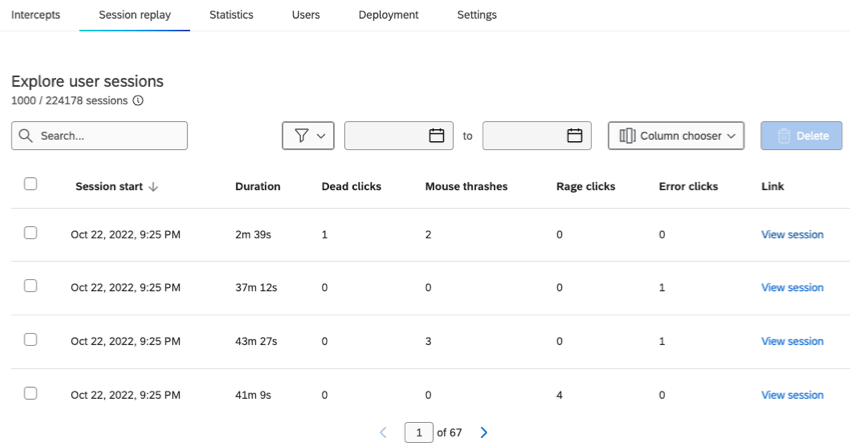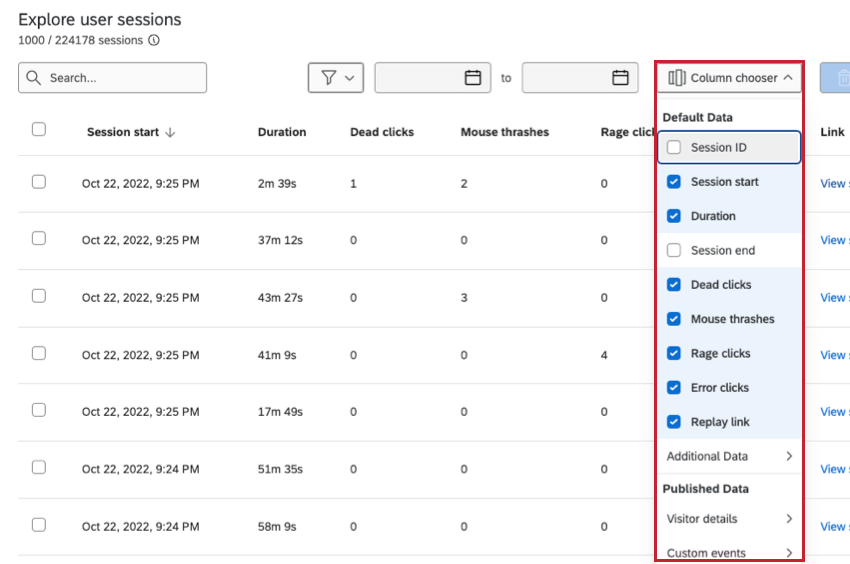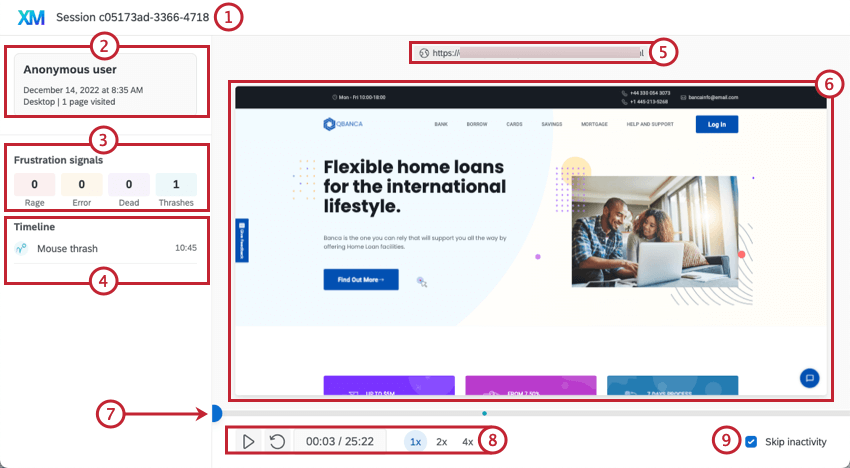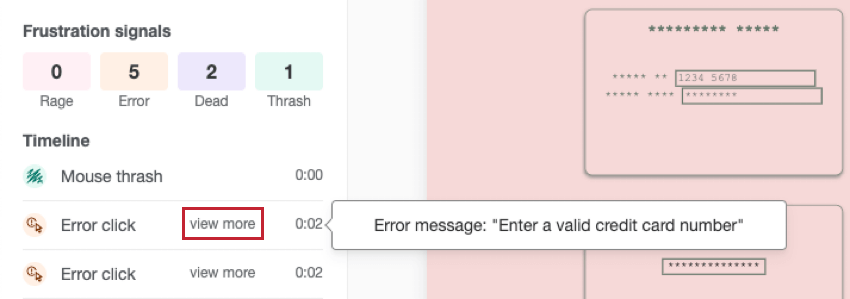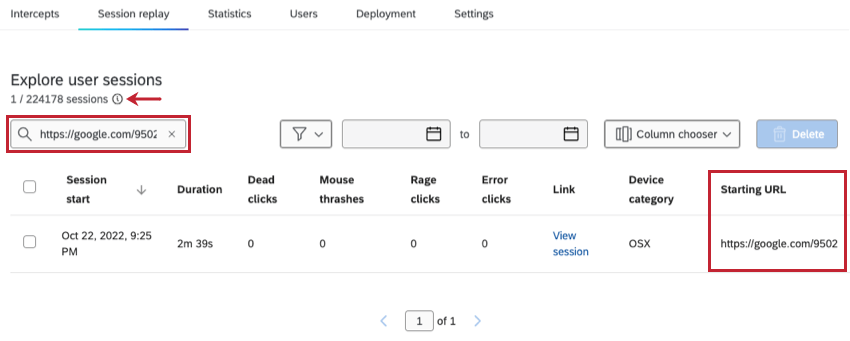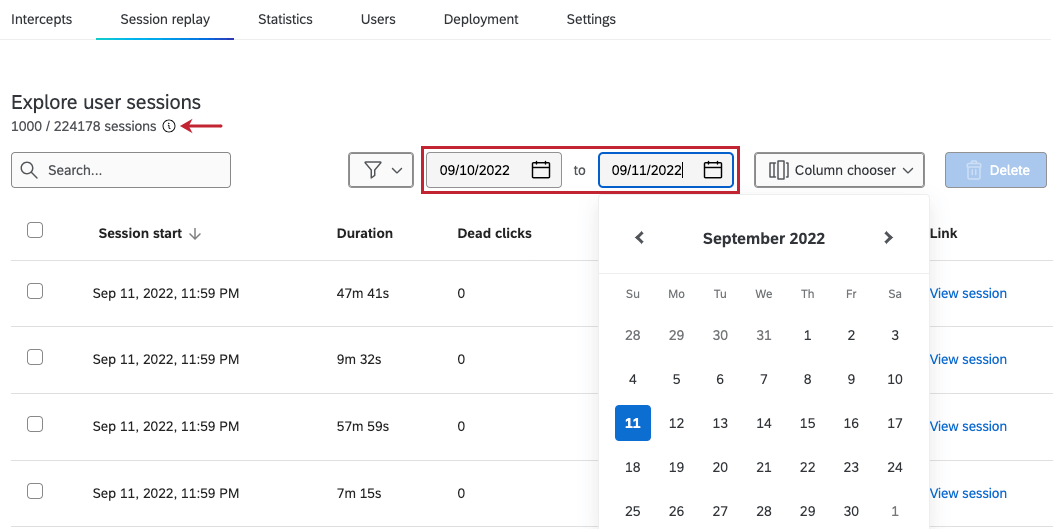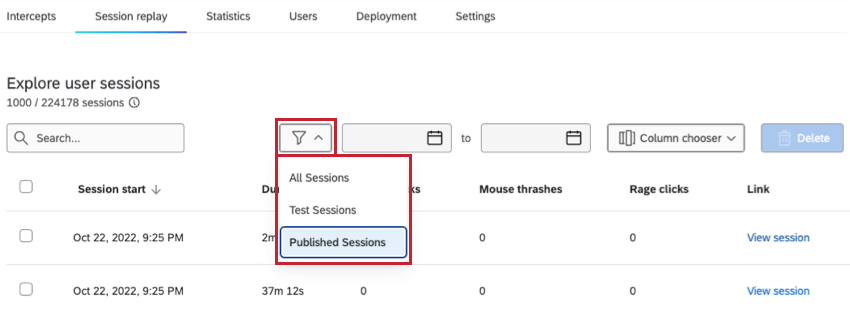Session Replay Tab
About the Session Replay Tab
Session replay reconstructs how a user experiences your website by capturing behavior such as mouse movements, page visits, and more. This allows you and your team to understand where any user frustration is happening to identify problem areas on your website and quickly and effectively improve the digital customer experience.
The session replay tab contains a table displaying all user sessions that have been recorded for your project. You can view details about each session, as well as watch a replay of individual sessions across your website. Sessions can also be searched for, filtered, and deleted in this tab.
The number of session results displayed in the table out of the project’s total number of sessions is displayed in the top-left corner. Click the arrows at the bottom to go to the next/previous page of results, or enter a page number to go to a specific page.
For information about adhering to applicable data privacy and security regulations while using session replay, see Data Security & Privacy for Digital Experience Analytics.
Available Fields
The session replay table displays details about users, frustration behaviors, and session information. The following fields are available in the session replay table:
Default Data
- Session ID: The unique ID of a specific session.
- Session start: The date and time the session started.
Qtip: The date and time is displayed in the timezone of your account.
- Duration: The length of the session. The maximum duration is 60 minutes.
- Session end: The date and time the session ended.
Qtip: The date and time is displayed in the timezone of your account.
- Dead clicks: The number of dead clicks that occurred during the session.
- Mouse thrashes: The number of mouse thrashes that occurred during the session.
- Rage clicks: The number of rage clicks that occurred during the session.
- Error clicks: The number of error clicks that occurred during the session.
- Replay link: A link to view a recording of the session.
Additional Data
- Device category: The category of device used for the session, either Desktop or Mobile Web.
- User agent: Details of the users’ browser and operating system.
- Referrer: The webpage a user was on right before they landed on your website.
- Starting URL: The URL of your site the session started on.
- Pages visited: The number of pages visited in the session.
If you’ve added and published visitor details or custom events while setting up session replay, you can also view those fields in this table.
Choosing Columns
You can use the column chooser to change the session replay fields that are displayed. The column options include all data recorded for each session, such as frustration behaviors, device information, and any published visitor details or custom events you’ve added.
To choose columns, navigate to the Session replay tab and click Column chooser, then select the session replay fields you want to display.
You can deselect a column to remove it. Columns currently displayed on the page will be noted with checkmarks.
Viewing User Sessions
In addition to viewing session information displayed in a table, you can view recordings of sessions by clicking View session. This will open the session in a new tab. Here you can view session details, as well as watch a recording of the session across your site. The main features on this tab include:
- The ID of the session.
- This section displays user information, including session start, device category, and pages visited. Any priority visitor details will also be displayed in this section.
- The Frustration signals section displays a count of which frustration signals, if any, occurred during the session, and when they occurred.
- The Timeline displays when frustration signals and custom events occurred during the session. Clicking on a specific event in the timeline will jump the recording directly to that point in the session.
- The current page URL the user is visiting in the session. This will automatically update as a user navigates to other pages throughout the recording.
- The session recording. This shows the user and their mouse activity as they navigate through your site.
- The interactive timeline. The exact time of frustration signals are displayed so you can quickly skip to where frustration happens without needing to view the entire session recording.
- These controls allow you to adjust the playback and speed of the session recording. Click the play icon to play the session recording, the pause button to stop it, and the back button to rewind 5 seconds. To the right you can view how far along you are in the recording, and choose a playback speed.
- This option lets you skip any inactivity within the session. When enabled, sections of the recording where the user is inactive on your site will be automatically skipped.
Features Incompatible with Session Replay
The following items will not be fully captured by session replay:
- Iframes: Iframes will appear as empty spaces on the site in a recorded session.
- Canvas elements: Canvas elements will appear as a rectangle containing an error message in a recorded session.
- Browser-specific elements: These are interactions handled natively by the browser or operating system and are not recordable. These include choosing an item from a dropdown, browser permission requests, and more.
- Cursors: The cursor in a recorded session will not reflect any custom stylings that may have been visible to the site user during the session. The cursor is also mainly transparent, which may make it difficult to see against dark backgrounds.
- Custom fonts: Custom fonts will not be displayed in a recorded session; default fonts will be displayed instead.
- Images: Images that require authentication will not be displayed in a recorded session. Images that are updated or re-uploaded will reflect the newest image in a recorded session.
- Date-time input: The pop-up calendar that displays when interacting with a date-time input field will not appear in a recorded session.
- Videos: Videos within a recorded session may not reflect the exact state of the video a user saw.
- Audio: Audio within a recorded session may not reflect the exact state of the audio a user heard.
- Highlighted text: Highlighting from clicking and dragging across elements will not display in a recorded session.
- Dropdown: Dropdown menus implemented with the <select> html tag will not display the list of items in a recorded sessions.
- Progress bar: Progress bars implemented with the <progress> html tag will continue to move forwards in a recorded session even if the playback is paused.
Searching and Filtering User Sessions
To view a subset of user sessions, you can enter a term in the search bar or filter your sessions by a date range or session type. When searching or filtering, the table will automatically adjust to show only user sessions that meet your search or filter criteria. The number of results displayed in the table will also update automatically.
Searching Sessions
Click into the search bar and enter a value to only display sessions that contain that value. You can search by any field with text values, such as Starting URL or any custom fields you’ve added. You can only search by 1 value at a time.
Filtering Sessions
To display sessions within a specific date range, click the calendar icons in the top-right of the page and select 2 dates to create your range. You can also type in a date in the MM/DD/YYYY format. This filters sessions by the Session start date and time. To reset the date filter, click each date and delete the text.
To filter sessions by type, click the filter icon and choose what type of session you want to display:
- All Sessions: Display all sessions in the table.
- Test Sessions: Display only test sessions in the table.
- Published Sessions: Display only published sessions in the table.
Deleting User Sessions
If you want to delete a session for any reason, click the checkbox to the left of the session and select Delete.
You can select multiple checkboxes to delete multiple sessions at the same time, or select the checkbox at the top of each page to select all sessions on that page.
